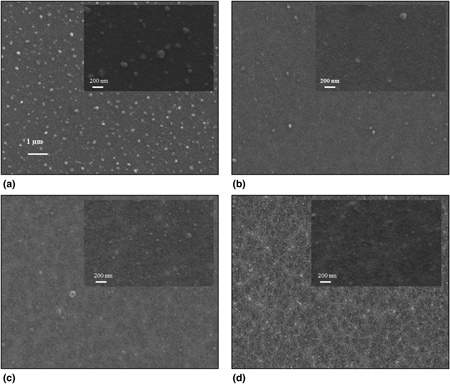Crossref Citations
This article has been cited by the following publications. This list is generated based on data provided by
Crossref.
Väyrynen, Katja
Hatanpää, Timo
Mattinen, Miika
Heikkilä, Mikko
Mizohata, Kenichiro
Meinander, Kristoffer
Räisänen, Jyrki
Ritala, Mikko
and
Leskelä, Markku
2018.
Diamine Adduct of Cobalt(II) Chloride as a Precursor for Atomic Layer Deposition of Stoichiometric Cobalt(II) Oxide and Reduction Thereof to Cobalt Metal Thin Films.
Chemistry of Materials,
Vol. 30,
Issue. 10,
p.
3499.
Palma, Juan L
Pereira, Alejandro
Álvaro, Raquel
García-Martín, José Miguel
and
Escrig, Juan
2018.
Magnetic properties of Fe3O4 antidot arrays synthesized by AFIR: atomic layer deposition, focused ion beam and thermal reduction.
Beilstein Journal of Nanotechnology,
Vol. 9,
Issue. ,
p.
1728.
Zhang, Zizhuo
Nallan, Himamshu C.
Coffey, Brennan M.
Ngo, Thong Q.
Pramanik, Tanmoy
Banerjee, Sanjay K.
and
Ekerdt, John G.
2019.
Atomic layer deposition of cobalt oxide on oxide substrates and low temperature reduction to form ultrathin cobalt metal films.
Journal of Vacuum Science & Technology A: Vacuum, Surfaces, and Films,
Vol. 37,
Issue. 1,
Zhang, Zizhuo
Dwyer, Tobias
Sirard, Stephen M.
and
Ekerdt, John G.
2019.
Area-selective atomic layer deposition of cobalt oxide to generate patterned cobalt films.
Journal of Vacuum Science & Technology A: Vacuum, Surfaces, and Films,
Vol. 37,
Issue. 2,
Saavedra, E
Burr, J P
Alburquenque, D
Palma, J L
García-Martín, J M
and
Escrig, J
2020.
Co/Ni multilayers ordered according to a periodic, Fibonnacci and Thue Morse sequence obtained by Atomic Layer Deposition.
Nano Express,
Vol. 1,
Issue. 2,
p.
020002.
Andalouci, A.
Brinza, O.
Porosnicu, C.
Lungu, C.
Mazaleyrat, F.
Roussigné, Y.
Chérif, S.M.
and
Farhat, S.
2020.
Morphological and magnetic study of plasma assisted solid-state dewetting of ultra-thin cobalt films on conductive titanium silicon nitride supports.
Thin Solid Films,
Vol. 703,
Issue. ,
p.
137973.
Malekpour, Soheil
Balkus, Kenneth J
and
Ferraris, John P
2021.
Hybrid supercapacitors using electrodes from fibers comprising polymer blend–metal oxide composites with polymethacrylic acid as chelating agent.
Nanotechnology,
Vol. 32,
Issue. 32,
p.
325401.
da Cunha, Tairan
Adjeroud, Noureddine
Guillot, Jérôme
Duez, Benoit
Lenoble, Damien
and
Arl, Didier
2022.
On the interplay between a novel iron and iron-carbide atomic layer deposition process, the carbon nanotube growth, and the metal–carbon nanotube coating properties on silica substrates.
Journal of Vacuum Science & Technology A,
Vol. 40,
Issue. 3,
Márquez, Paulina
Patiño Vidal, Cristian
Pereira, Alejandro
Vivas, Leonardo
Palma, Juan Luis
López de Dicastillo, Carol
and
Escrig, Juan
2022.
Hollow Iron Oxide Nanospheres Obtained through a Combination of Atomic Layer Deposition and Electrospraying Technologies.
Nanomaterials,
Vol. 12,
Issue. 18,
p.
3180.
Jussila, Topias
Philip, Anish
Tripathi, Tripurari
Nielsch, Kornelius
and
Karppinen, Maarit
2023.
Atomic layer deposition of magnetic thin films: Basic processes, engineering efforts, and road forward.
Applied Physics Reviews,
Vol. 10,
Issue. 4,
Saad, Rana
Abdelkarem, Khaled
El Sayed, Adel M.
Shaban, Mohamed
Ahmed, Inas A.
Tammam, M. T.
and
Hamdy, Hany
2024.
Characterization and enhanced carbon dioxide sensing performance of spin-coated Na- and Li-doped and Co-doped cobalt oxide thin films.
RSC Advances,
Vol. 14,
Issue. 49,
p.
36852.



